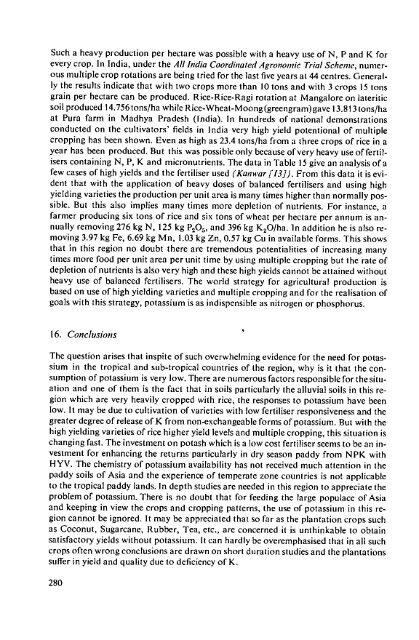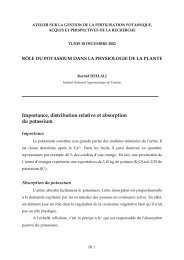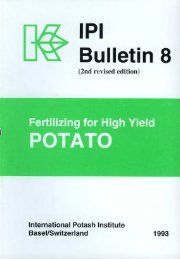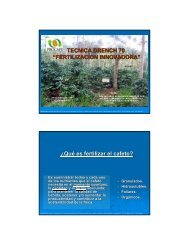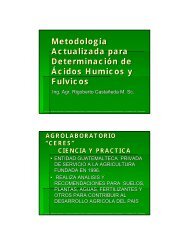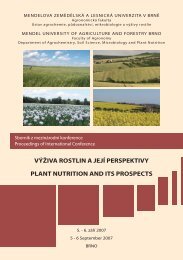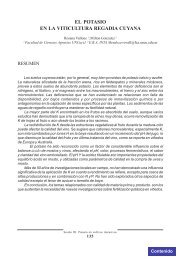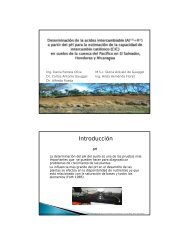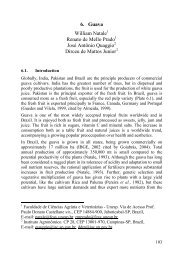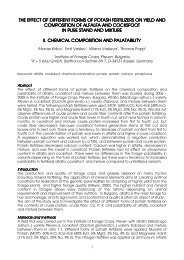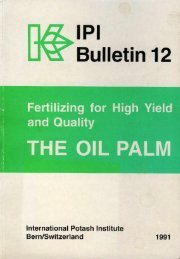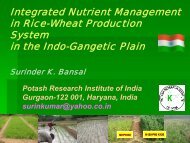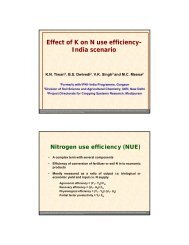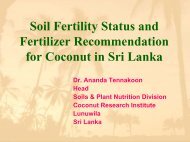Potassium Research and Agricultural Production - The International ...
Potassium Research and Agricultural Production - The International ...
Potassium Research and Agricultural Production - The International ...
Create successful ePaper yourself
Turn your PDF publications into a flip-book with our unique Google optimized e-Paper software.
Such a heavy production per hectare was possible with a heavy use of N, P <strong>and</strong> K for<br />
every crop. In India, under the AI/India Coordinated Agronomic Trial Scheme, numerous<br />
multiple crop rotations are being tried for the last five years at 44 centres. Generally<br />
the results indicate that with two crops more than 10 tons <strong>and</strong> with 3 crops 15 tons<br />
grain per hectare can be produced. Rice-Rice-Ragi rotation at Mangalore on lateritic<br />
soil produced 14.756 tons/ha while Rice-Wheat-Moong (greengram)gave 13.813 tons/ha<br />
at Pura farm in Madhya Pradesh (India). In hundreds of national demonstrations<br />
conducted on the cultivators' fields in India very high yield potentional of multiple<br />
cropping has been shown. Even as high as 23.4 tons/ha from a three crops of rice in a<br />
year has been produced. But this was possible only because of very heavy use offertilisers<br />
containing N, P, K <strong>and</strong> micronutrients. <strong>The</strong> data in Table 15 give an analysis ofa<br />
few cases of high yields <strong>and</strong> the fertiliser used (KanH'ar [I3J). From this data it is evident<br />
that with the application of heavy doses of balanced fertilisers <strong>and</strong> using high<br />
yielding varieties the production per unit area is many times higher than normally possible.<br />
But this also implies many times more depletion of nutrients. For instance, a<br />
farmer producing six tons of rice <strong>and</strong> six tons of wheat per hectare per annum is annually<br />
removing 276 kg N, 125 kg P,O" <strong>and</strong> 396 kg K,Ojha. In addition he is also removing<br />
3.97 kg Fe, 6.69 kg Mn, 1.03 kg Zn, 0.57 kg Cu in available forms. This shows<br />
that in this region no doubt there are tremendous potentialities of increasing many<br />
times more food per unit area per unit time by using multiple cropping but the rate of<br />
depletion of nutrients is also very high <strong>and</strong> these high yields cannot be attained without<br />
heavy use of balanced fertilisers. <strong>The</strong> world strategy for agricultural production is<br />
based on use of high yielding varieties <strong>and</strong> multiple cropping <strong>and</strong> for the realisation of<br />
goals with this strategy, potassium is as indispensible as nitrogen or phosphorus.<br />
16. Conclusions<br />
<strong>The</strong> Question arises that inspite of such overwhelming evidence for the need for potassium<br />
in the tropical <strong>and</strong> sub-tropical countries of the region, why is it that the consumption<br />
of potassium is very low. <strong>The</strong>re are numerous factors responsible for the situalion<br />
<strong>and</strong> one of them is the fact that in soils particularly the alluvial soils in this region<br />
which are very heavily cropped with rice, the responses to potassium have been<br />
Iow. It may be due to cultivation of varieties with low fertiliser responsiveness <strong>and</strong> the<br />
greater degree of release of K from non-exchangeable forms of potassium. But with the<br />
high yielding varieties of rice higher yield levels <strong>and</strong> multiple cropping, this situation is<br />
changing fast. <strong>The</strong> investment on potash which is a low cost fertiliser seems to be an investment<br />
for enhancing the returns particularly in dry season paddy from NPK with<br />
HYV. <strong>The</strong> chemistry of potassium availability has not received much attention in the<br />
paddy soils of Asia <strong>and</strong> the experience of temperate zone countries is not applicable<br />
to the tropical paddy l<strong>and</strong>s. In depth studies are needed in this region to appreciate the<br />
problem of potassium. <strong>The</strong>re is no doubt that for feeding the large populace of Asia<br />
<strong>and</strong> keeping in view the crops <strong>and</strong> cropping patterns, the use of potassium in this region<br />
cannot be ignored. It may be appreciated that so far as the plantation crops such<br />
as Coconut, Sugarcane, Rubber, Tea, etc., are concerned it is unthinkable to obtain<br />
satisfactory yields without potassium. It can hardly be overemphasised that in all such<br />
crops often wrong conclusions are drawn on short duration studies <strong>and</strong> the plantations<br />
suffer in yield <strong>and</strong> Quality due to deficiency of K.<br />
280


